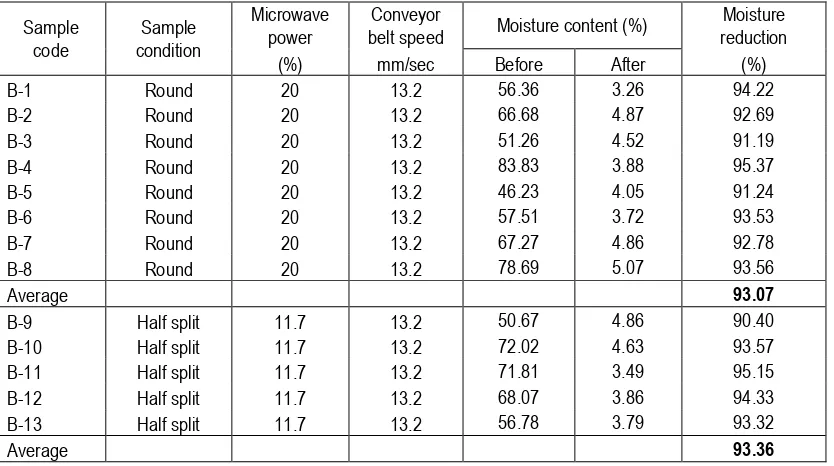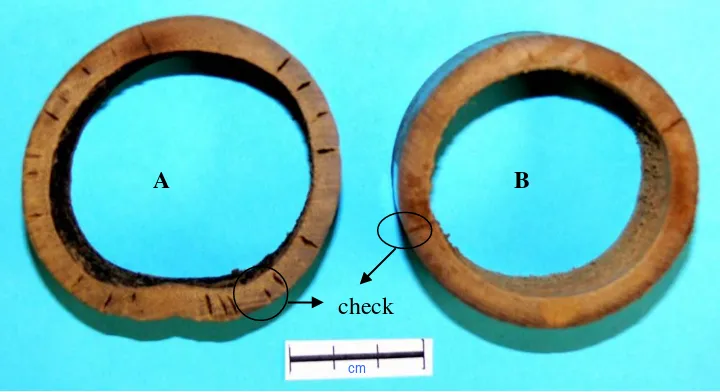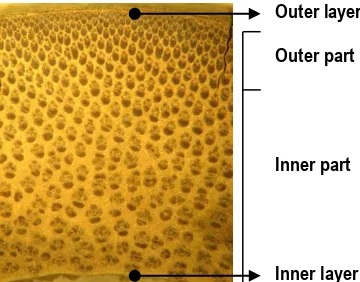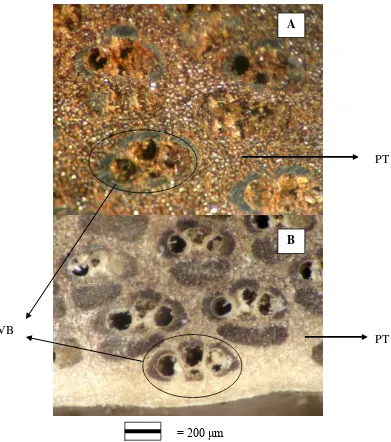The Effect of Microwave Heating on Permeability of Bamboo
Krisdianto
Abstract
Bamboos are plants of enormous importance to the rural people in several regions of Asia. In spite of its many excellent properties; bamboo is liable to biological deterioration. Therefore, a preservative treatment is regarded as necessary. Many methods have been developed to increase the durability of bamboo. However, most of the methods take a long time and in most cases the vessels do not take enough liquid to preserve the surrounding fibres and parenchyma. This study is aimed to observe the effect of microwave heating on bamboo permeability. The study evaluates the moisture content reduction, resin uptake and saturation as well as resin distribution.
The result shows that microwave heating is able to reduce the moisture content reduction of both round and split bamboo up to 93% in about 3 minutes. The microwave heating increases the resin uptake of microwave treated bamboo up to 3 ~ 5 times. The resin saturation also improves to about 2.5 ~ 3 times (before curing) and about 4 ~ 5 times (after curing). Resin penetrates mostly through radial checks that occur during drying. Microwave heated samples shows more blackened area in ground parenchyma tissue than non-treated samples, which indicates that the resin was distributed more evenly. It is concluded that microwave heating leads to improve of bamboo permeability. It is recommended that further research be carried out to establish a microwave regime for optimal bamboo permeability.
Key words: bamboo, preservative, microwave, resin, permeability
Introduction
Bamboos are plants of enormous importance to the rural people in several regions of Asia, such as Indonesia, Vietnam, China and India. Bamboo is used for house construction, scaffolding, ladders, mats, baskets, fencing, containers, tool handles, pipes, toys, musical instruments, cooking pots, furniture and handicrafts (Lessard 1980; Recht and Wetterwald 1992). In spite of its many excellent properties, bamboo is liable to attack by fungi such as brown rot, white rot, soft rot and by insects such as beetles and termites. In general, untreated bamboo may have an average life of less than 1 ~ 3 years when it is exposed to atmosphere and soil. When used indoor, bamboo may be expected to last 4 ~ 7 years (Liese 1980b). Therefore, a preservative treatment is regarded as necessary (Farrelly 1984).
The treatability of bamboo is in general rather low (Liese 1980b). It varies according to species, age and moisture content of the culm, treatment method and type of preservative. The water absorption in bamboo is also generally slower than in wood species. Therefore the soaking period has to be considerably longer than that for wood of the same dimensions.
Many methods have been developed to increase the durability of bamboo. However, most of the methods take a long time and in most cases the vessels do not take
In the last decade, microwave technology has been developed to improve timber treatability. Controlled application of microwave heating to green timber can directly manipulate wood density and moisture permeability (Vinden and Torgovnikov, 2000; Ximing et al. 2002). Microwave energy modifies the wood structure during a very short burst of intense microwave heating that blasts tiny holes through the wood, to provide better connectivity between the wood cells. This allows water to escape more quickly from the timber and the tiny holes allows preservative penetrate easily to the timber (Vinden and Torgovnikov 1996; 2000). As a ligno-cellulosic material, bamboo also has an opportunity to be treated using microwave application to improve its permeability.
This study is aimed to observe the effect of microwave heating on bamboo permeability. The study evaluates the moisture content reduction, resin uptake and saturation as well as resin distribution.
Material and Methods water to gain more moisture for microwave treatment.
bamboos were heated by 11.6% of the power as the scooping trial showed that higher power level microwave resulted in burning bamboo. The moisture content of bamboo before and after microwave heating were measured from about 1 cm thick samples in two locations of the long shoot bamboo.
All samples were then put it in cylindrical treatment plant for impregnation. Bamboo samples were evacuated using vacuum pressure for 10 minutes followed by FFA measured using formula mentioned by Mc Quire (1975).
U2 = [(M3– M1) / Vt],
where:
U2 = resin uptake after curing (kg/m3)
M1 = mass of initial bamboo (before impregnation)
M3 = mass of resin cured bamboo (kg)
Vt = volume of bamboo after curing
The percentage of bamboo saturation with resin before and after curing was calculated as below: Saturation of bamboo with resin (%) = 100 x (U1/Fr)
Saturation of cured bamboo with resin (%) = 100 x (U2/Fr)
where:
U1 = initial resin uptake before curing (kg/m3)
Fr = Maximum resin uptake (kg/m3), Fr = F x dr
F = maximum possible absorption (kg/L) = 1000 – [dw (g + 66.7)/100]
dr = density of resin kg/L
dw = density of bamboo
For resin distribution observation, the control samples (non-microwave heated samples) were oven dried to obtain 4% moisture content. This is conducted to facilitate FFA resin to penetrate the samples.
Results and Discussions
The Effect of Microwave Heating on Moisture Content
The moisture content of samples before and after microwave heating is summarised in Table 1. The table also gives the percentage of moisture content reduction.
The average moisture content reduction of both round and split bamboo is about 93%. This provides evidence that split bamboo requires lower power of microwave to obtain equal moisture content reduction. The scooping trial also shows that heating split bamboo using higher level of microwave power caused bamboo to burn.
Wilcoxon test of moisture content before and after microwave heating shows significant differences. This indicates that microwave heating is able to significantly reduce the moisture content.
During microwave heating water is drawn from bamboo cells allowing bamboo material to dry. The microwave heating process took about 3 minutes to complete. This is much quicker than other methods which may take several weeks, such as air drying. However, the instant drying caused the cell of the soft tissue closing pack together and caused checks in cell structure of bamboo (Figure 1).
Table 1. Moisture content of bamboo heated by microwave.
Sample
belt speed Moisture content (%)
Figure 1. Microwave heated bamboo (A) and air dried bamboo (B).
Table 2. Average resin uptake and saturation of bamboo with FFA resin.
Sample Group Resin uptake Saturation (%)
after curing (kgm-3) before curing after curing
Control
Half split 0.0094 0.28 0.10
Round 0.0138 0.41 0.15
Microwave treated
Half split 0.0521 1.16 0.56
Round 0.0638 1.27 0.69
As seen in Figure 1, checks happened more in microwave heated bamboo (A), while less check occur happened during air drying of bamboo (B).
As there are no ray cells in the bamboo tissue, the checks that occur in the bamboo tissue facilitating an easy movement of liquids in the radial direction. The micro checks of timber during drying also increases its permeability (Vinden and Torgovnikov 2000). The effect of micro checks of bamboo during microwave heating is discussed in resin distribution.
The Effect of Microwave Heating on Resin Uptake
Similar with treatment on wood, microwave heating on bamboo resulted in the improvement of resin uptake. Table 2 summaries the average resin uptake and saturation of bamboo after microwave heating.
The result shows that the resin uptake of both split and round bamboos which were heated by microwave are higher than those of non-treated bamboo samples. In split samples, after microwave treatment resin uptake was 0.0521 kgm-3, while non-treated bamboo uptake was
0.0094 kgm-3. In round bamboo, the uptake of microwave
treated bamboo was 0.0638 kgm-3 while non-treated
bamboo is about 0.0138 kgm-3. In general, the resin
uptake of microwave treated bamboo is about 3 ~ 5 times higher than non-treated bamboo.
The resin saturation result aligns with the resin uptake. Before curing, the saturation of resin in microwave treated bamboo is about 2.5 ~ 3 times higher than non-treated bamboo. After curing, the saturation of microwave treated bamboo with is about 4 ~ 5 times higher than non-treated bamboo.
The paired t-test results between microwave treated and non-treated bamboo and between half split and round bamboo are shown in Table 3, which means there is significant differences of the resin uptake between microwaves treated samples and control samples.
A
B
check
Table 3. Paired samples t-test.
Pair – 1 Pair – 2
Treated and Non-treated Split and Round
Pair differences Mean 0.0459000 0.0163444
Std. Deviation 0.0152047 0.0245256 layers is through the checks that occur during drying.
Figure 2. Anatomical structure of bamboo.
Figure 3. FFA resin penetrates through checks.
In non-microwave treated bamboo, the black darkened area concentrated around the checks (Figure 3), while brighter area means no FFA resin impregnated. It is understood that FFA resin penetrates mostly through checks that happened during oven drying.
The resin distributions differences of non-microwave heated and microwave heated samples are shown in Figure 4.
Figure 4 A shows that the black darkened mark of FFA resin mostly in ground parenchyma tissue, while non treated bamboo shows yellow bright of ground parenchyma tissue (Figure 4B). It can be concluded that FFA resin movement in bamboo samples is mostly by diffusion from parenchyma cell to the other cell, which mostly take a part on ground parenchyma tissue. In microwave heated samples, resin mostly distributed in the inner part of bamboo, which is softener than outer. Vascular bundles in inner part are less frequent than outer part (Liese 1980a).
As most of inner part of bamboo was darkened by FFA resin, it is possible that resin penetrates through micro checks that happen in the inner layer that cannot be seen by direct eyes. The micro checks break through the layers that cover the cells from inside and facilitate an easy movement of liquids in radial direction. As a result in microwave heated bamboos, the resin distributed more evenly.
Conclusions and Suggestions
Based on the results can be concluded as follows:
• Microwave heating is able to reduce the moisture content reduction of both round and split bamboo up to 93% in about 3 minutes.
• The split bamboo requires lower power of microwave to obtain equal moisture content reduction.
• The resin uptake of microwave treated bamboo is about 3 ~ 5 times higher than non-treated bamboo.
• Before curing, the saturation of resin in microwave treated bamboo is about 2.5 ~ 3 times higher than non-treated bamboo. After curing, the saturation of
Figure 4. FFA resin treated of microwave heated (A) and control (B) of bamboo. Remarks: VB = vascular bundle, PT = ground parenchyma tissue.
microwave treated bamboo with is about 4 ~ 5 times higher than non-treated bamboo.
• FFA resin distributed more evenly in microwave treated than control. Resin penetrates through micro checks that occur in inner layer of bamboo.
• Further research needs to be carried out :
• To establish a microwave schedule for optimal bamboo permeability.
• To evaluate strength reduction of microwave treated bamboo
• To study consumer preference caused by bamboo deformation during microwave heating.
References
Farrelly, D. 1984. The Book of Bamboo. Sierra Club Books, San Francisco.
Lessard, G. 1980. Foreword. Proceeding of a Workshop held in Singapore, 28 - 30 May.
Liese, W. 1980a. Anatomy of Bamboo. Proceeding of a Workshop held in Singapore, 28 - 30 May. p 161-164.
Liese, W. 1980b. Preservation of Bamboos. Proceeding of a Workshop held in Singapore, 28 - 30 May. p 165 - 172.
VB
PT
PT
= 200 μm
A
Liese, W. 1985. Bamboos: Biology, Silvics, Properties, Utilization. Deutsche Gesellschaft fur Technische Zusammenarbeit (GTZ) GmbH.
McQuire, A.J. 1975. Effect of Wood Density on Preservative Retention in Fence Posts. New Zealand Journal of Forestry 5(1):105-109.
Recht, C. and M.F. Wetterwald. 1992. Bamboos. Timber Press, Portland, Oregon.
Vinden, P. and G. Torgovnikov. 1996. A Method for Increasing the Permeability of Wood. Patent No. PO 0850/96. Australia.
Vinden, P. and G. Torgovnikov. 2000. The Physical Manipulation of Wood Properties Using Microwave. IUFRO Eucalyptus Working Party Conference Proceedings, 19-24 March 2000. Launceston, Tasmania. 240 - 247.
Ximing, W.; X. ZhengHua; S. LiHui; Z. WeiHua. 2002. Preliminary Study on Microwave Modified Wood. China Wood Industry 16(4):16 -19.
Received : 10 March 2008 Accepted : 16 Juni 2008 Final revision : 24 Juni 2008
Krisdianto
PhD student of School of Forest and Ecosystem Science, The University of Melbourne,
Water St., Creswick, Australia.



